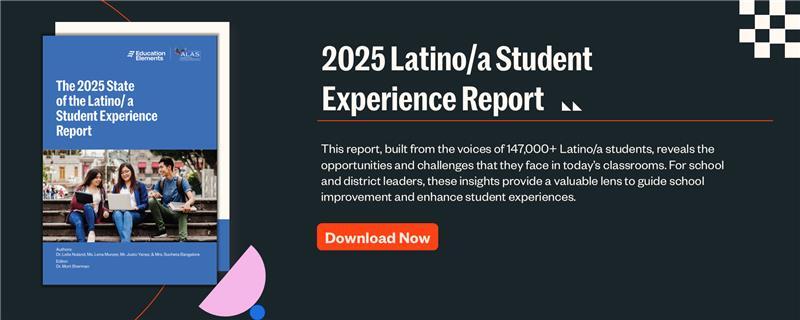The 2025 State of the Latino/a Student Experience
At a Glance: The Latino/a Student Experience
147,000+ Latino/a student voices captured through the 7Cs Survey
Largest & fastest-growing student group in U.S. schools
-0.76 drop in Care scores for Latino/a students between upper elementary and middle school—larger than for non-Latino peers
Latina students report consistently lower Care scores than male peers in middle and high school
Top 3 Takeaways
Belonging and care decline steeply in middle school.
Latina students face compounded identity-based challenges.
Structural inequities amplify gaps in opportunity.
We’ve talked to and met educators across the country in communities large and small, urban and rural, and asked a question: Do our students feel seen?
When we meet with superintendents, principals, and teachers across the country, they share the same refrain: we want to do right by every student. However, the students whose voices most need to be heard to help reshape our systems are the very ones least often heard. Latino/a students, the largest and fastest-growing group in our schools, are telling us something urgent.
Students often share that they don’t think their teachers know them. The data in this report reveals sharp drops in perceived care, especially as students move from the close caring environments of classrooms in elementary schools to the highly structured environments of middle and high school. And the data are clear: care matters! In achievement, attendance, career and life goals, and health.
Listening to Student Voices
Every year, millions of Latino/a students walk into classrooms carrying with them not only notebooks and backpacks, but also the dreams of their families and communities. Latino/a students represent the largest and fastest-growing student group in U.S. schools. Their experiences will play a large part in defining the future of our workforce, democracy, and civic life.
The 2025 State of the Latino/a Student Experience Report, based on over 147,000 student voices gathered through the 7Cs Survey, offers both a mirror and a call to action. The data show clear strengths, especially in upper elementary years where students report high levels of teacher care and engagement. They also expose sharp declines in support as students transition to middle and high school. Persistent gaps for Latina students, and structural inequities amplify these challenges.
The central lesson is clear: Latino/a students are not asking for less rigor or fewer expectations. They are asking to be seen, heard, and supported.
What the Data Tell Us
The 7Cs framework—Care, Confer, Captivate, Clarify, Consolidate, Challenge, and Classroom Management—measures how students experience teaching and learning. Three findings stand out:
- The Middle School Drop
Latino/a students report the highest 7Cs scores in upper elementary, but scores fall significantly in middle school, particularly in Care. This decline is steeper than that of non-Latino peers, signaling that Latino/a students lose relational support at a critical moment for identity development and academic persistence. - Latina Students Feel Less Supported
Latina students in middle and high school consistently rate Care lower than male peers, particularly on items like “My teacher seems to know if something is bothering me.” These gaps point to intersectional challenges where gender and ethnicity combine to deepen inequities in belonging and support. - Structural Barriers Amplify Experience Gaps
Lower perceptions of Care intersect with systemic challenges—such as limited access to guidance counselors, culturally responsive coursework, and rigorous college-prep opportunities. Latino/a students hold ambitious academic aspirations (Foxen, UnidosUS); yet, without sustained encouragement and guidance, these aspirations often stall before reaching college or career.
Why This Matters
The story these numbers tell is not just about relationships, but about opportunity. When students feel cared for and connected, they are more likely to persist in challenging work, ask for help, and envision themselves on postsecondary pathways. When they don’t, they may internalize limiting narratives about their potential.
Belonging is not static; it fluctuates across classes and teachers (Oleniacz, 2022). Teachers who embed culturally responsive practices and maintain high expectations protect against declines in engagement (Turcios-Cotto & Milan, 2013). Conversely, stereotype threat and lack of representation disproportionately affect Latina students’ outcomes (Taggart, 2018).
Key Research Threads
● Belonging fluctuates by classroom: Engagement rises where students feel connected (Oleniacz, 2022).
● High expectations + cultural relevance matter: Counter deficit narratives and affirm identity (Turcios-Cotto & Milan, 2013).
● Representation reduces stereotype threat: Visibility of Latina/o voices improves outcomes (Taggart, 2018).
Now What?
School and district leaders can act on this data:
● Strengthen relational supports in secondary schools. Provide professional learning for middle and high school teachers to emphasize relationship-building, personalized feedback, and student voice in daily practice for all students.
● Embed culturally responsive practices. Move beyond “add-on” moments of representation to fully integrate Latino/a language, culture, and identity into curricula and school rituals, just as we would with any significant part of the American experience.
● Guide postsecondary transitions with care. Pair students with near-peer mentors, provide bilingual workshops, and affirm high expectations while giving practical tools for college and career planning.
● Center Latina student voices. Establish advisory councils, pair Latina students with mentors, and audit curriculum for Latina representation to counter stereotype threat and build confidence.
So What?
The implications are clear: our systems were not designed with Latino/a students at the center; yet, their success is integral to define our collective future. Every drop in “Care” scores is more than a statistic. It is a student telling us, “I’m not sure my teacher sees me.”
The promise of personalized learning is that no student should feel invisible. Latino/a students bring brilliance, resilience, and aspirations to our classrooms every day. When schools recognize these assets, build authentic relationships, and affirm cultural identity as a strength, students thrive—not in spite of who they are, but because of who they are.
At Education Elements, we believe personalized learning is not a program, but a promise: a promise that every student is known, valued, and challenged to reach their full potential. This report reminds us that for Latino/a students, keeping that promise is both urgent and essential. It is up to us—as educators, leaders, and communities—to ensure that schools are places where every student feels seen, supported, and inspired to achieve their dreams.





